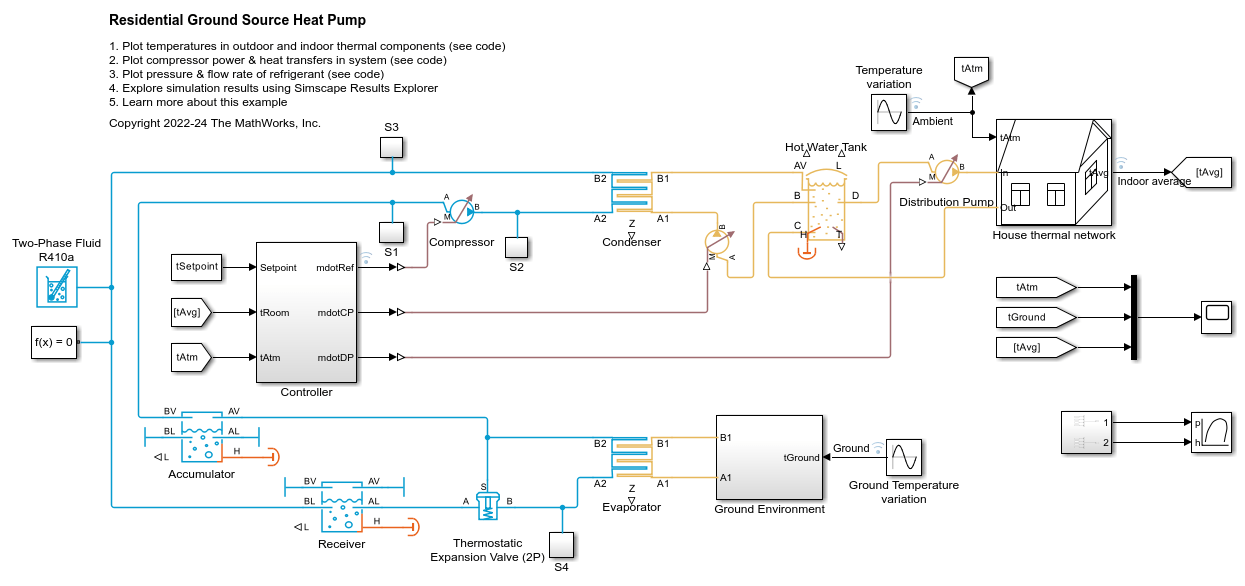Pipe Bend (TL)
Libraries:
Simscape /
Fluids /
Isothermal Liquid /
Pipes & Fittings
Description
The Pipe Bend (TL) block models a curved pipe in a thermal liquid network. You can define the pipe characteristics to calculate losses due to friction and pipe curvature and optionally model fluid compressibility.
Pipe Curvature Loss Coefficient
The coefficient for pressure losses due to geometry changes comprises an angle correction factor, Cangle, and a bend coefficient, Cbend:
The block calculates Cangle as:
where θ is the value of the Bend angle parameter, in degrees.
The block calculates Cbend from the tabulated ratio of the bend radius, r, to the pipe diameter, d, for 90° bends from data based on Crane [1]:

| r/d | 1 | 1.5 | 2 | 3 | 4 | 6 | 8 | 10 | 12 | 14 | 16 | 20 | 24 |
|---|---|---|---|---|---|---|---|---|---|---|---|---|---|
| K | 20 fT | 14 fT | 12 fT | 12 fT | 14 fT | 17 fT | 24 fT | 30 fT | 34 fT | 38 fT | 42 fT | 50 fT | 58 fT |
The block interpolates the friction factor, fT, for clean commercial steel from tabular data based on the pipe diameter [1]. This table contains the pipe friction data for clean commercial steel pipe with flow in the zone of complete turbulence.
| Nominal size (mm) | 5 | 10 | 15 | 20 | 25 | 32 | 40 | 50 | 72.5 | 100 | 125 | 150 | 225 | 350 | 609.5 |
|---|---|---|---|---|---|---|---|---|---|---|---|---|---|---|---|
| Friction factor, fT | .035 | .029 | .027 | .025 | .023 | .022 | .021 | .019 | .018 | .017 | .016 | .015 | .014 | .013 | .012 |
The correction factor is valid for a ratio of bend radius to diameter between 1 and 24. Beyond this range, the block employs nearest-neighbor extrapolation.
Losses Due to Friction in Laminar Flows
The pressure loss formulations are the same for the flow at ports A and B.
When the flow in the pipe is fully laminar, or below Re = 2000, the pressure loss over the bend is:
where:
μ is the fluid dynamic viscosity.
λ is the Darcy friction factor constant, which is 64 for laminar flow.
ρI is the internal fluid density.
d is the pipe diameter.
L is the bend length segment, the product of the Bend radius and the Bend angle:
A is the pipe cross-sectional area,
is the mass flow rate at the respective port.
Losses due to Friction in Turbulent Flows
When the flow is fully turbulent, or greater than Re = 4000, the pressure loss in the pipe is:
where fD is the Darcy friction factor. This is approximated by the empirical Haaland equation and is based on the Internal surface absolute roughness. The differential is taken over half of the pipe segment, between port A to an internal node, and between the internal node and port B.
Pressure Differential for Incompressible Fluids
When the flow is incompressible, the pressure loss over the bend is
where g is the value of the Gravitational acceleration parameter and Δz is the value of the Elevation gain from port A to port B parameter.
Pressure Differential for Compressible Fluids
When the flow is compressible, the block calculates the pressure loss over the bend based on the internal fluid volume pressure, pI,
Mass Conservation
When you clear the Enable dynamic compressibility checkbox, the mass flow into the pipe equals the mass flow out of the pipe:
When select Enable dynamic compressibility, the pipe mass conservation equation is
where:
pI is the thermal liquid pressure at the internal node I.
I is the rate of change of the thermal liquid temperature at the internal node I.
βI is the thermal liquid bulk modulus.
α is the liquid thermal expansion coefficient.
Energy Conservation
The energy conservation equation for the block is
where:
ϕA is the energy flow rate at port A.
ϕB is the energy flow rate at port B.
If the fluid is incompressible, the energy accumulation rate is
where:
cpI is the fluid specific heat at the internal node of the block.
V is the pipe volume.
ρ0 is the fluid density. The block calculates this value from the Nominal liquid temperature and Nominal liquid pressure parameters.
If the fluid is compressible, the energy accumulation rate is

